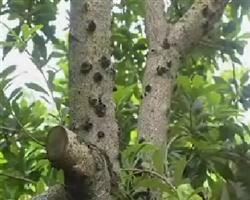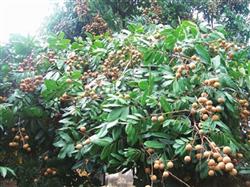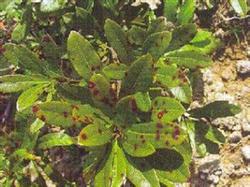Several common diseases and insect pests affecting the tree potential of red bayberry

Diseases and insect pests such as cancer, brown spot, leaf roll moth and pine caterpillar have great influence on the tree potential and yield of red bayberry. Prevention should be given priority to in production and comprehensive control should be carried out. In addition to taking measures such as increasing the application of organic fertilizer and potash fertilizer and clearing the garden in winter, the growing season should take timely and effective measures according to the occurrence law of diseases and insect pests to eliminate them before major occurrence. one. Cancer disease, also known as bayberry sore, is a bacterial disease, which often occurs on tree trunks and branches, which has a great impact on tree potential and yield. The disease spread through Rain Water, invaded from the wound, and began to occur in late May. At the beginning of the disease, the disease produced milky white bulges, and then gradually swollen, forming a very rough dark brown tumor. For prevention and treatment, in addition to protecting the branches from damage, the tumor can be removed with a sharp knife after the rain in spring and autumn (until the new tissue is now), and the wound can be smeared with "402" antibacterial agent 50: 100 times solution, or agricultural streptomycin 200 mg / L, 0.1% potassium permanganate, or 70% alcohol, copper sulfate 100 times solution to disinfection protection, apply again after half a month, scrape off the tumor tissue to burn. two. Brown spot is a fungal disease, which damages leaves once a year, causing a large number of fallen leaves in autumn and winter, and withering flower buds and branchlets, which has a great impact on tree potential and yield. 20-30 days before and after fruit harvest, fungicides such as 1 ∶ 2 ∶ 200 Bordeaux solution, 70% methyl thiophanate 800 × 1000 times solution, 65% Dysen zinc 600 times solution and other fungicides can be controlled. When the loss of control causes a large number of leaves to fall in autumn and winter, combined with extra-root topdressing, the crown can be controlled by spraying an internal fungicide such as 70% methyl topiramate 800 × 1000 times plus 2mem4mi D10 20 mg / L. three. Branch rot often occurs in old and weak trees. The branches rot and die after the disease, which affects the tree potential and causes the tree to decline early. In production, the disease spot can be scraped off in the early stage, the dead branches can be sawed off, and the wound can be prevented and treated with disinfectant. Curettage method is the same as cancer disease. four. The leaf roll moth has two generations a year, mostly from the end of May to the middle of June and from July to August. Silking will concentrate the food damage on the young leaves or shoots, which will affect the growth and photosynthesis of the new shoots. The larval occurrence period can be combined with the prevention and control of brown spot, such as 90% trichlorfon 800 × 1000 times, or 2.5% deltamethrin 2000 × 3000 times, or 80% dichlorvos 800 × 1000 times, or 1.8% avermectin 2000 × 3000 times, or 50% phoxim 1000 times and other insecticides to spray the crown to control. five. Dendrolimus punctatus produces one generation a year, hatches larvae in early April, and the larval period is 35-40 days. The newly hatched larvae clustered on the surface of the tender leaves on the new shoots, leaving only a layer of epidermis, and then dispersed the food damage, the food intake increased greatly, and in serious cases, the leaves only left veins. When larvae are found in trees in mid-late April, insecticides can be sprayed to kill them, and the control agents are the same as those of leaf rollers. six. Shell insects mainly include cypress oyster scale and camphor net shield scale, which cause withered branches and leaves of bayberry trees. There are two generations in a year, the first generation occurs in the period of young fruit expansion of red bayberry (May ~ June), and the second generation occurs after fruit harvest (July ~ August). In order to reduce the effect of pesticide residues on fruit, the second generation of young scale is often used in the incubation period after fruit harvesting. The medicament can be 1000 times of thiazinone or 80 times of detergent, 40% of dimethoate or 1000 times of quick culling. Individual seriously damaged plants can be prevented and cured by drying with 40% dimethoate, an internal insecticide, after fruit harvest. seven. The main termites are black-winged termites and yellow-winged termites, which eat into the root neck and the xylem of the trunk, resulting in tree weakness or death, especially the trunk of the old tree. The period from April to October is a harmful period for termite activities. in production, it can be eliminated by digging ant nests to kill queens, stacking grass (digging shallow holes 10 cm deep and 50 cm in diameter, putting in tender grass sprayed with 1000 times of trichlorfon or 48% Lesben + 1% brown sugar, and covered with thin soil), lighting lamp traps at dusk after May-June rain. eight. Longicorn beetles that harm red bayberry include longicorn beetles and longicorn beetles, which use larvae to drill into the tree trunk, resulting in tree decline or death. Most of the adults lay eggs from April to August. The branches can be brushed white (from late March to early April to prevent adults from spawning), wormhole hooks can be used to kill larvae with steel wire when there is fresh insect feces in the wormholes, or cotton balls dipped in dichlorvos or dimethoate 5x 10 times liquid and gasoline can be stuffed after being removed, or they can also be injected with syringes. And use wet mud to seal wormholes), branch spraying (spraying tree trunks with 40% dimethoate or Lesbon 500-1000 times liquid from April to August, about once in 15 days to kill oviposition adults and newly hatched larvae), artificial killing when adults occur, and so on.
- Prev

Problems and Countermeasures of out-of-season Longan cultivation
Potassium chlorate was first used to promote flowers in longan in Taiwan, and the out-of-season cultivation of longan in production began in Thailand. In recent years, longan production areas in our province are also trying to use potassium chlorate to promote flower cultivation of out-of-season longan, some of which have achieved certain economic benefits, but most orchards have poor or even no.
- Next

Main Diseases and Control methods of Waxberry
1. Bayberry cancer disease 1. Symptoms: red bayberry cancer disease is a bacterial disease. Mainly damage the branches of 2-3-year-old fruit trees, mostly form tumors on the branches, the tumor is nearly spherical, the size is different, the cork is very hard, brown to dark brown. In general, the tumor on the branch begins to grow in early April, 7-8.
Related
- Moge, come on! The staff of the peasant association in the producing area of cantaloupe were frightened when the crowd gathered.
- Causes and Solutions of low Fruit setting rate of Apple
- Symptoms and control measures of passion fruit virus disease
- Fruit growing lesson: how do apple orchards keep high yields?
- Can you build orchards in the mountains? What are the pros and cons?
- How to manage the coloring period of Crisson grape?
- This paper introduces the processing technology of two kinds of fig products.
- How much is a month for retired teachers in rural areas by 2020?
- How can strawberry planting increase sugar content? We should pay attention to management in many aspects.
- What are the cultivation techniques on how to improve the yield of golden fruit?

